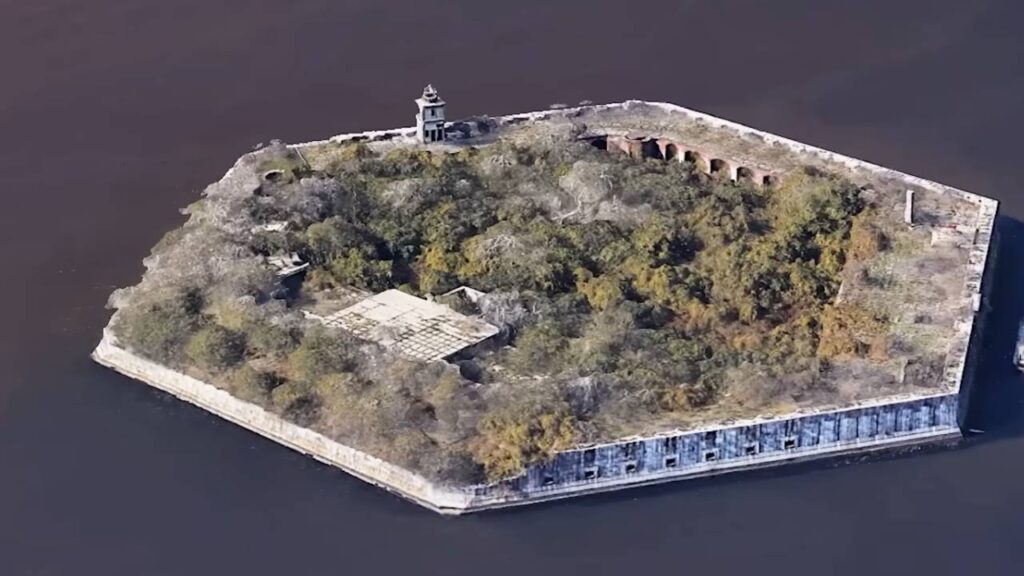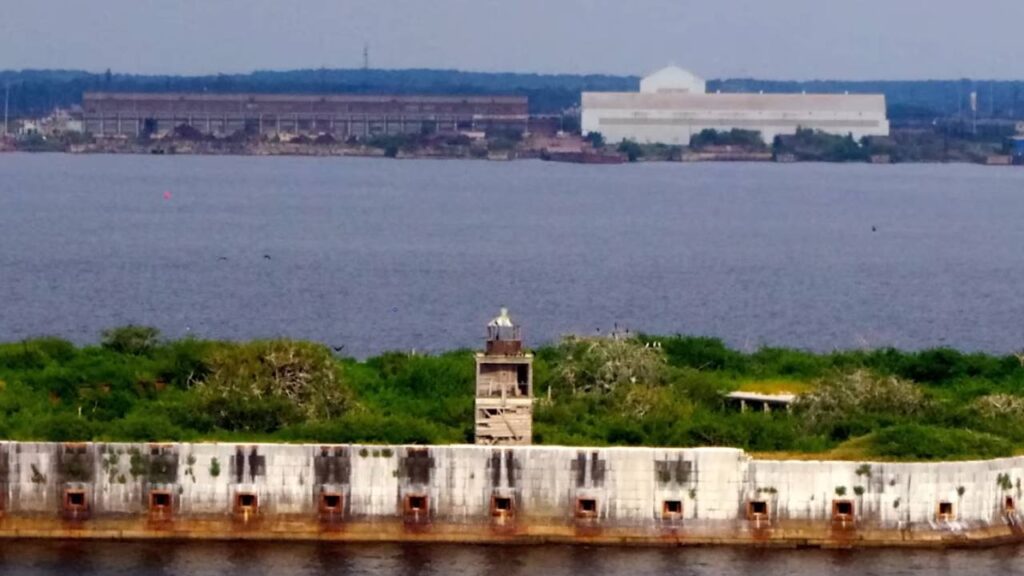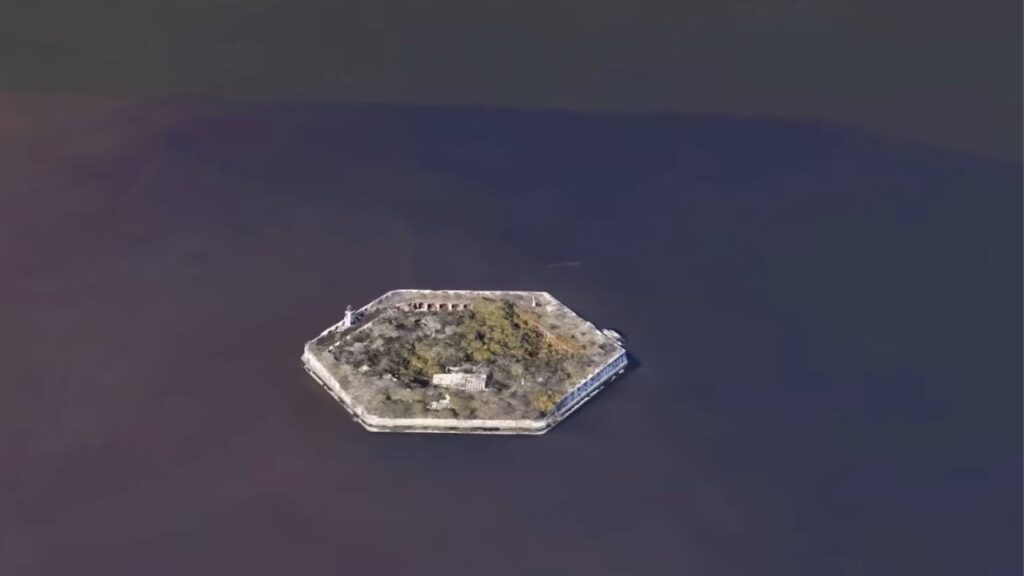In the middle of the Patapsco River near Baltimore, Fort Carroll stands as one of Maryland’s most intriguing and historic landmarks. Though abandoned and closed to the public, its crumbling walls, rich history, and isolated setting continue to draw the attention of explorers, photographers, and travelers with a passion for hidden places. If planning a visit from outside the United States, it’s important to be prepared—take a moment to review these important USA travel visa tips to ensure a smooth and hassle-free trip.
Chimney Rock State Park: Best Time, Entrance Fee & What to Do
This includes everything you need to know about Fort Carroll, from how to get there and when to go, to its fascinating past and the best locations to view it from shore or water.
Where is Fort Carroll Located?

Fort Carroll is located in the Patapsco River, near the entrance to Baltimore Harbor, Maryland. The artificial island sits about 8 miles south of downtown Baltimore, between Fort Armistead Park and the Francis Scott Key Bridge (I-695). Surrounded by water on all sides, Fort Carroll was strategically placed in the 1800s to guard the approach to Baltimore from potential naval threats.
Logan Utah Temple: Prices,When & How to Capture Stunning Shots
Despite being in close proximity to the city, Fort Carroll is not accessible by road or walking trails. The only way to get near the fort is by water—via private boat, kayak, or by viewing it from nearby coastal areas or the bridge. Its isolated position enhances the mystery and intrigue surrounding this long-abandoned site. If you’re using GPS, you can locate Fort Armistead Park as your closest land-based viewpoint to begin your exploration.
History of Fort Carroll
Story of Fort Carroll dates back to 1847, during a time when coastal cities were rapidly developing defense systems to protect key ports. The U.S. War Department selected a site in the Patapsco River for a man-made island fort to protect the shipping lanes leading to Baltimore. The task of designing and overseeing its construction was given to Captain Robert E. Lee, who later became a prominent Confederate general during the Civil War.

Named after Charles Carroll of Carrollton, a Maryland signer of the Declaration of Independence, the fort was originally built to house artillery and barracks for troops. It was intended to be a first line of defense for Baltimore against potential enemy ships. However, advancements in military technology and artillery made the design of Fort Carroll obsolete even before its completion.
Cathedral Basilica of Saint Louis: Photos, Hours, Tickets & Facts
Despite undergoing minor updates during the Civil War, Spanish-American War, and World War I, Fort Carroll never played a direct role in combat. By the early 20th century, it was abandoned by the military and left to deteriorate. Over time, nature reclaimed the space—turning it into a nesting ground for seabirds and a hauntingly beautiful ruin visible only from the water or afar.
Today, it stands as a monument to forgotten military engineering—an artificial island with a rich past and an uncertain future.
Who Owns Fort Carroll Now?
While Fort Carroll may look like an abandoned government facility, it is actually privately owned. In 1958, a Baltimore attorney named Benjamin Eisenberg purchased the fort from the federal government for a mere $10,000. His dream was to redevelop the fort into a casino, hotel, or entertainment hub. Unfortunately, those plans never materialized due to the fort’s deteriorating structure, inaccessibility, and environmental complications.
Since then, the property has changed hands, but no major restoration projects have been completed. The fort remains privately held, and its current owners have made no public announcements about plans for renovation or tourism development. As of now, public entry is strictly prohibited, and the structure is considered unsafe to explore due to its crumbling foundation, overgrown vegetation, and lack of infrastructure.
The ownership status adds a layer of legal complexity for those hoping to explore the fort firsthand. While its exterior can be admired from a safe distance, setting foot on Fort Carroll without permission would be considered trespassing.
How to Visit Fort Carroll
Although you cannot legally or safely enter Fort Carroll, there are still various ways to view and experience it from a distance. The island remains a point of interest for many who want to admire its ghostly remains and photograph its overgrown walls rising from the water.

Here are your options:
1. Boat Tours & Private Charters
Some local boat tour operators in the Baltimore area offer private charters that pass near Fort Carroll. These guided tours typically provide a historical narration about the fort’s past, making them a great choice for photographers and history lovers. Boat trips offer the closest safe proximity to the structure, giving you a chance to see the architecture and surrounding ecosystem up close—without stepping on the island itself.
2. Kayaking Adventures
For experienced paddlers, kayaking to Fort Carroll is a thrilling and immersive experience, but it comes with safety risks. Strong river currents, boat traffic, and weather changes make kayaking near the island suitable only for those with proper equipment and skills. While you can approach the fort closely, do not attempt to land or enter due to safety and legal concerns.
3. Land-Based Viewing
If water travel isn’t your preference, the best land-based option is from Fort Armistead Park or nearby viewpoints near the Francis Scott Key Bridge. These locations allow you to view Fort Carroll from a distance, especially with binoculars or a camera with a zoom lens. It’s a peaceful way to experience the fort’s atmosphere without setting sail.
Best Views of Fort Carroll
Finding the perfect spot to see Fort Carroll can completely transform your experience. Although you can’t set foot on the island, several strategic viewpoints let you capture stunning photos and soak in the fort’s mysterious vibe.
Fort Armistead Park
Fort Armistead Park offers the best land-based view of Fort Carroll. Situated near the Key Bridge, this peaceful park features benches, wooded trails, and elevated areas that give you a clear line of sight to the fort. Bring your camera or telescope for a better view. As a bonus, you can also explore the park’s own historic military ruins and enjoy its natural surroundings.
Francis Scott Key Bridge (I-695)
While driving eastbound over the Key Bridge, glance south for a dramatic overhead view of Fort Carroll. You can’t stop or walk along the bridge, but the aerial angle provides one of the clearest visual contexts for understanding the fort’s strategic location in the Patapsco River.
Water-Level Boat or Kayak Views
Approach Fort Carroll by boat or kayak to enjoy a full 360-degree view of its crumbling walls, graffiti-covered surfaces, and overgrown courtyards. This water-level perspective highlights the fort’s isolation and historic strength—making it ideal for drone footage, close-up photography, and adventure-seeking explorers.
Fort Carroll Hours & Price
Since Fort Carroll is closed to the public, there are no official hours of operation or general admission prices. You cannot visit the island directly unless you have special permission from the private owner, which is extremely rare and typically not granted for casual visitors.
Viewing Fort Carroll from nearby parks or boats is free or dependent on the provider:
- Fort Armistead Park: Open from dawn to dusk, free of charge.
- Boat Charters: Range from $50 to $150 per person, depending on the tour duration and amenities.
- Kayak Rentals: Typically $25–$35/hour in nearby rental facilities, though bringing your own kayak is also an option.
Keep in mind that there are no services or facilities on Fort Carroll, so all visits are entirely external and observational.
Fort Carroll Nearby Locations
Make the most of your trip by exploring other nearby attractions that complement your Fort Carroll visit. These locations provide additional history, recreation, and nature experiences.
Fort Armistead Park
Just a short walk or drive from the viewing points, this park features historical bunkers, picnic areas, and trails. It’s quiet, often uncrowded, and ideal for nature walks or setting up a camera to photograph Fort Carroll.
Baltimore Inner Harbor
Only a 15–20 minute drive north, Baltimore’s Inner Harbor offers a wide range of activities, from historic ships like the USS Constellation to the National Aquarium, waterfront dining, and museums. It’s a great way to round out your historical journey.
Masonville Cove Environmental Education Center
Located in nearby Curtis Bay, Masonville Cove is an urban nature sanctuary with wetland trails, birdwatching spots, and environmental exhibits. You can sometimes spot Fort Carroll from its shorelines, especially with binoculars.
North Point State Park
This scenic state park features remnants of World War II-era facilities, beaches, and peaceful trails. Located a bit further east, it’s worth visiting for those who want a mix of history and coastal views.
From the comfort of a nearby park bench or the deck of a passing boat, Fort Carroll tells a silent story of ambition, abandonment, and time. While it remains closed to foot traffic, it is still very much open to the imagination.
FAQs
1. Where is Fort Carroll located?
Fort Carroll sits in the Patapsco River near Baltimore, Maryland, just southeast of the Francis Scott Key Bridge (I-695). You can view it best from Fort Armistead Park or by boat.
2. Can I visit Fort Carroll?
No, you cannot enter Fort Carroll. The structure is privately owned and considered unsafe, so public access is not allowed.
3. Who built Fort Carroll?
The U.S. Army Corps of Engineers began constructing Fort Carroll in 1847, under the supervision of Robert E. Lee, who was then a captain.
4. Why was Fort Carroll built?
The government built Fort Carroll to protect Baltimore Harbor from naval attacks. It was part of a broader system of coastal defenses.
5. Does Fort Carroll have a military history?
Yes, Fort Carroll briefly served military purposes during the Civil War, Spanish-American War, and World War I, but it never saw combat.
6. Who owns Fort Carroll now?
A private owner holds the title to Fort Carroll. Baltimore attorney Benjamin Eisenberg bought it in 1958, and it remains in private hands today.
7. How can I see Fort Carroll?
You can view Fort Carroll from Fort Armistead Park or from the water by taking a boat or kayak near the island. Some local boat tours may pass by it.
8. Is there an entry fee to visit Fort Carroll?
There is no entry fee because the island is not open to visitors. However, boat tours or rentals near the fort may charge a fee.
9. What wildlife can I see at Fort Carroll?
Seabirds, including herons and gulls, have made Fort Carroll their home. The overgrown structure has become a natural nesting habitat.
10. Are there any plans to restore Fort Carroll?
So far, no restoration projects have taken place. While several redevelopment ideas were proposed over the years, none have moved forward.






